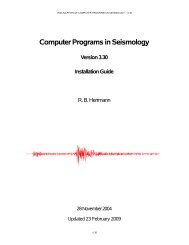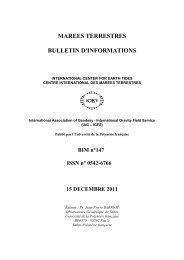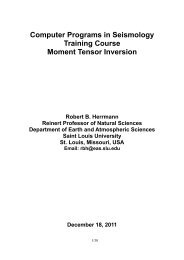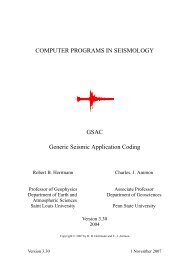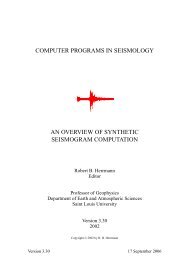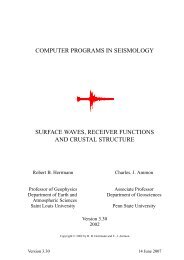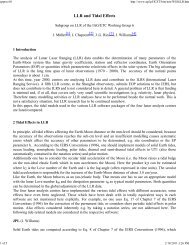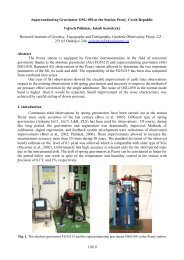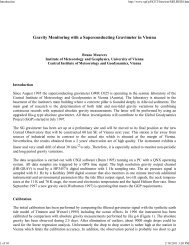3.04 Gravimetric Methods – Superconducting Gravity Meters
3.04 Gravimetric Methods – Superconducting Gravity Meters
3.04 Gravimetric Methods – Superconducting Gravity Meters
Create successful ePaper yourself
Turn your PDF publications into a flip-book with our unique Google optimized e-Paper software.
108 <strong>Superconducting</strong> <strong>Gravity</strong> <strong>Meters</strong><br />
(a)<br />
nm s <strong>–</strong>2<br />
(b)<br />
mm<br />
(c)<br />
mm<br />
11.0<br />
7.0<br />
3.0<br />
<strong>–</strong>1.0<br />
4/18/00<br />
8.0<br />
6.0<br />
4.0<br />
2.0<br />
4/22/00 4/26/00 4/30/00<br />
0.0<br />
4/18/00 4/22/00 4/26/00 4/30/00<br />
590.0<br />
570.0<br />
550.0<br />
530.0<br />
510.0<br />
490.0<br />
4/18/00 4/22/00 4/26/00 4/30/00<br />
Figure 26 <strong>Gravity</strong> residual observations (a),<br />
accumulated precipitation (per hour) (b), and groundwater<br />
table level (c) at Moxa, Germany, from 18 Apr. to 2 May 2000.<br />
Reproduced from Kroner C, Jahr T, and Jentzsch G (2004)<br />
Resultsfrom44monthsofobservationswitha<br />
superconducting gravimeter at Moxa/Germany. Journal of<br />
Geodynamics 38(3<strong>–</strong>5): 263<strong>–</strong>280, with permission from Elsevier.<br />
<strong>3.04</strong>.3.7 Earth Rotation<br />
At the long period end of the observable spectrum of<br />
gravity (Figure 15), there are two isolated theoretical<br />
periods of the Earth’s normal-mode spectrum. One is<br />
the inner-core wobble (ICW), whose period is of the<br />
order of years. For model PREM, wobble programs<br />
yield a value of about 700 days, but the theory is<br />
hardly suitable for such a long-period motion.<br />
Mathews et al. (2002) quote a value of 6.6 yr that is<br />
derived from their theory and with VLBI observations<br />
and models, but at either period the predicted<br />
small amplitude makes this a difficult target (e.g.,<br />
Guo et al., 2006).<br />
The other mode is much more accessible, and is<br />
of course the CW, with a period of about 435 days in<br />
the mantle reference frame. This is one of the two<br />
components of polar motion normally seen in gravity<br />
studies, the other being the smaller amplitude forced<br />
annual wobble that is seen in combination with<br />
the annual tide and other seasonal effects. Note that<br />
at much longer periods there is an 18.6 lunisolar<br />
year tide that will be extremely difficult to<br />
identify in gravity. Discussion of Richter’s (1983)<br />
observation of the CW has been mentioned earlier<br />
and almost every SG in the GGP network has<br />
reported a clear signal of the CW <strong>–</strong> see, for example,<br />
Richter et al. (1995b) and Sato et al. (1997b) for the<br />
Japanese Antarctic station. Here, we review only a<br />
few results.<br />
Loyer et al. (1999) showed the importance of using<br />
a long data set when trying to infer the transfer<br />
function of the polar motion; clearly more than<br />
nm s <strong>–</strong>2<br />
Cantley (CA)<br />
120<br />
<strong>Gravity</strong> residuals<br />
100<br />
Hydrology<br />
Snow<br />
80<br />
60<br />
40<br />
20<br />
0<br />
<strong>–</strong>20<br />
<strong>–</strong>40<br />
<strong>–</strong>60<br />
<strong>–</strong>80<br />
1997 1998 1999 2000 2001 2002 2003 2004<br />
Year<br />
nm s <strong>–</strong>2<br />
100<br />
80<br />
60<br />
40<br />
20<br />
0<br />
<strong>–</strong>20<br />
<strong>–</strong>40<br />
Wettzell (WE)<br />
<strong>Gravity</strong> residuals<br />
Hydrology<br />
Snow<br />
<strong>–</strong>60<br />
1999.5 2000 2000.5 2001 2001.5 2002 2002.5 2003 2003.5<br />
Year<br />
Figure 27 <strong>Gravity</strong> residuals, hydrology (soil moisture þ snow), and snow-modeled contributions at stations Cantley<br />
(Canada) and Wettzell (Germany). Reproduced from Boy J-P and Hinderer J (2006) Study of the seasonal gravity signal in<br />
superconducting gravimeter data. Journal of Geodynamics 41: 227<strong>–</strong>233, with permission from Elsevier.




